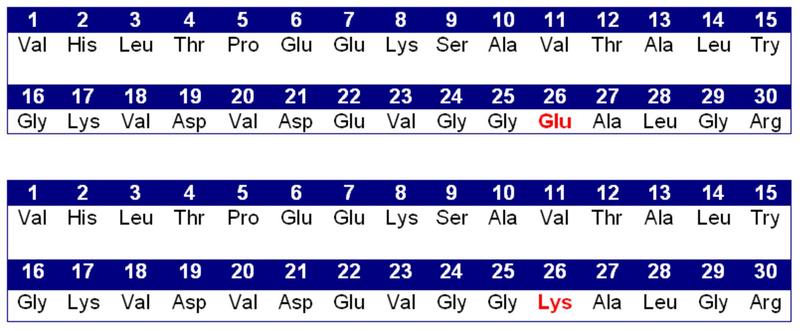Hemoglobin E
|
WikiDoc Resources for Hemoglobin E |
|
Articles |
|---|
|
Most recent articles on Hemoglobin E Most cited articles on Hemoglobin E |
|
Media |
|
Powerpoint slides on Hemoglobin E |
|
Evidence Based Medicine |
|
Clinical Trials |
|
Ongoing Trials on Hemoglobin E at Clinical Trials.gov Clinical Trials on Hemoglobin E at Google
|
|
Guidelines / Policies / Govt |
|
US National Guidelines Clearinghouse on Hemoglobin E
|
|
Books |
|
News |
|
Commentary |
|
Definitions |
|
Patient Resources / Community |
|
Patient resources on Hemoglobin E Discussion groups on Hemoglobin E Patient Handouts on Hemoglobin E Directions to Hospitals Treating Hemoglobin E Risk calculators and risk factors for Hemoglobin E
|
|
Healthcare Provider Resources |
|
Causes & Risk Factors for Hemoglobin E |
|
Continuing Medical Education (CME) |
|
International |
|
|
|
Business |
|
Experimental / Informatics |
Editor-In-Chief: C. Michael Gibson, M.S., M.D. [1]
Overview

Hemoglobin E or haemoglobin E (HbE) is an abnormal hemoglobin with a single point mutation in the β chain. At position 26 there is a change in the amino acid, from glutamic acid to lysine. HbE is one of the most common variant of normal hemoglobin. Hemoglobin E can be detected on electrophoresis. This hemoglobin variant is very common in Southeast Asia and it has a low frequency in black and white people.
The βE mutation affects β-gene expression creating an alternate splicing site in the mRNA at codons 25-27 of the β-globin gene. Through this mechanism, there is a mild deficiency in normal β mRNA and production of small amounts of anomalous β mRNA. The reduced synthesis of β chain may cause β thalassemia. Also, this hemoglobin variant has a weak union between α and β globin, causing instability when there is a high amount of oxidant.[1]
Hemoglobin E disease (EE)
Hemoglobin E disease results when the offspring inherits the gene for HbE from both parents. At birth, babies homozygous for the hemoglobin E allele do not present symptoms due to HbF (fetal hemoglobin) they still have. In the first months of life, fetal hemoglobin disappears and the amount of hemoglobin E increases, so the subjects start to have a mild β thalassemia. People with hemoglobin E do not show any symptoms (there is usually no anemia or hemolysis). Subjects homozygous for the hemoglobin E allele have a mild hemolytic anemia and mild splenomegaly.
Hemoglobin E trait: heterozygotes for HbE (AE)
Heterozygous AE occurs when the gene for haemoglobin E is inherited from one parent and the gene for haemoglobin A from the other. This is called hemoglobin E trait, and it is not a disease. People who have hemoglobin E trait (heterozygous) are asymptomatic and their state does not usually result in health problems. They may have a low mean corpuscular volume (MCV) and very abnormal red blood cells (target cells). Its clinical relevance is exclusively due to the potential for transmitting E or β thalassemia. [citation needed]
Heterozygotes for HbE (SE)
Compound heterozygotes with hemoglobin sickle E disease result when the gene of hemoglobin E is inherited from one parent and the gene for hemoglobin S from the other. As the amount of fetal hemoglobin decreases and hemoglobin S increases, a mild hemolytic anemia appears in the early stage of development.
Hemoglobin E/β-thalassaemia
People who have hemoglobin E/β thalassemia have inherited one gene for hemoglobin E from one parent and one gene for β thalassemia from the other parent. Hemoglobin E/β thalassemia is a severe disease and it still has not got a universal cure. It affects more than a million people in the world[2]. The consequences of hemoglobin E/β thalassemia when it is not treated can be heart failure, the enlargement of the liver, problems in the bones, etc.
There is a variety of genotypes depending on the interaction of HbE and α thalassemia. The presence of the α thalassemia reduces the among of HbE usually found in HbE heterozygotes. In other cases, in combination with certain thalassemia mutations, it provides an increased resistance to malaria (P. falciparum).[3]
Epidemiology
Hemoglobin E is most prevalent in Southeast Asia (Thailand, Myanmar, Cambodia, Laos, Vietnam[4]), where its prevalence can reach 30 or 40%, and North-East India, where in certain areas carrier rates reach 60% of the population. In Thailand the mutation can reach 50 or 70%, and it is higher in the North-East of the country. It is also found in China, the Philippines, Turkey, Nepal, Sri Lanka, Pakistan, etc. The mutation is estimated to have arisen within the last 5,000 years[5]. In Europe there have been found cases of families with hemoglobin E, but in these cases, the mutation differs from the one found in South-East Asia. This means that there may be different origins of the βE mutation.[6][7]
External links
- http://www.doh.wa.gov/ehsphl/phl/newborn/pubs/HBEFactSheet.pdf
- http://asheducationbook.hematologylibrary.org/content/2007/1/79.full
- http://www.orpha.net/data/patho/GB/uk-HbE.pdf
- http://www.ncbi.nlm.nih.gov/pmc/articles/PMC1684388/pdf/ajhg00163-0214.pdf
References
- ↑ Chernoff AI, Minnich V, Nanakorn S, et al. Studies on hemoglobin E. I. The clinical, hematologic, and genetic characteristics of the hemoglobin E syndromes. J Lab Clin Med. 1956;47:455–489
- ↑ Vichinsky E. Hemoglobin E Syndomes. ASH Education Book 2007; vol. 2007 no. 1: 79-83.
- ↑ Bachir D and Galacteros F. Hemoglobin E disease. Orphanet Encyclopedia. November 2004.
- ↑ http://www.urmc.rochester.edu/medicine/genetics/media/documents/hemoE.pdf
- ↑ Ohashi et al., 2004
- ↑ Kazazian HH, JR., Waber PG, Boehm CD, Lee JI, Antonarakis SE, Fairbanks VF. Hemoglobin E in Europeans: Further Evidence for Multiple Origins of the βE-Globin Gene. Am J Hum Genet 1984; 36:212-217.
- ↑ Bain BJ. Blood cells: a practical guide, 4th ed. Oxford, UK: Blackwell; 2006.
| This protein-related article is a stub. You can help Wikipedia by expanding it. |